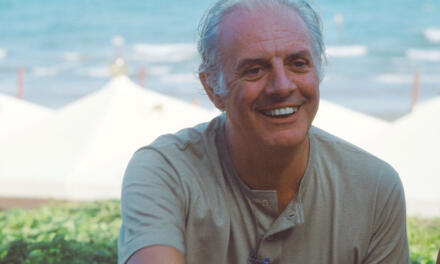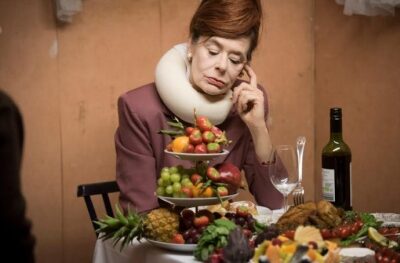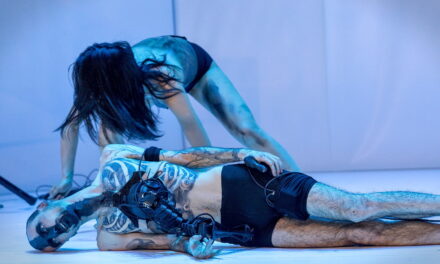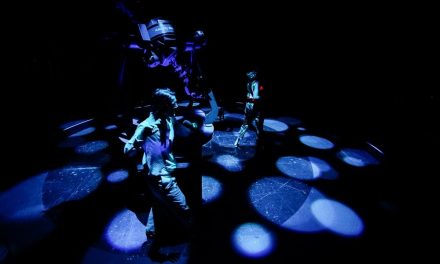Peeping Tom is a theatre company founded in 2000 in Brussels by Gabriela Carrizo and Franck Chartier. Their work, which “unites community theatre, contemporary dance, acrobatics, cabaret and the avant-garde,”[1] is acclaimed worldwide. Both of the founders are keen to emphasize that this is a theatre company, not merely dance.
Carrizo and Chartier come from different countries (Gabriela is from Argentina and Franck is from France) and from different dance backgrounds. Chartier studied classical ballet in Cannes and was a part of Maurice Bèjart’s Ballet du XXe Siècle between 1986 and 1989. Three years later he danced with Anjelin Preljoçaj. Carrizo came to Europe and trained as a contemporary dancer at Córdoba’s University Ballet, where she also made her first work as a choreographer. Carrizo and Chartier met at Alain Platel’s les ballets C de la B in 1997, where they both worked as dancers.
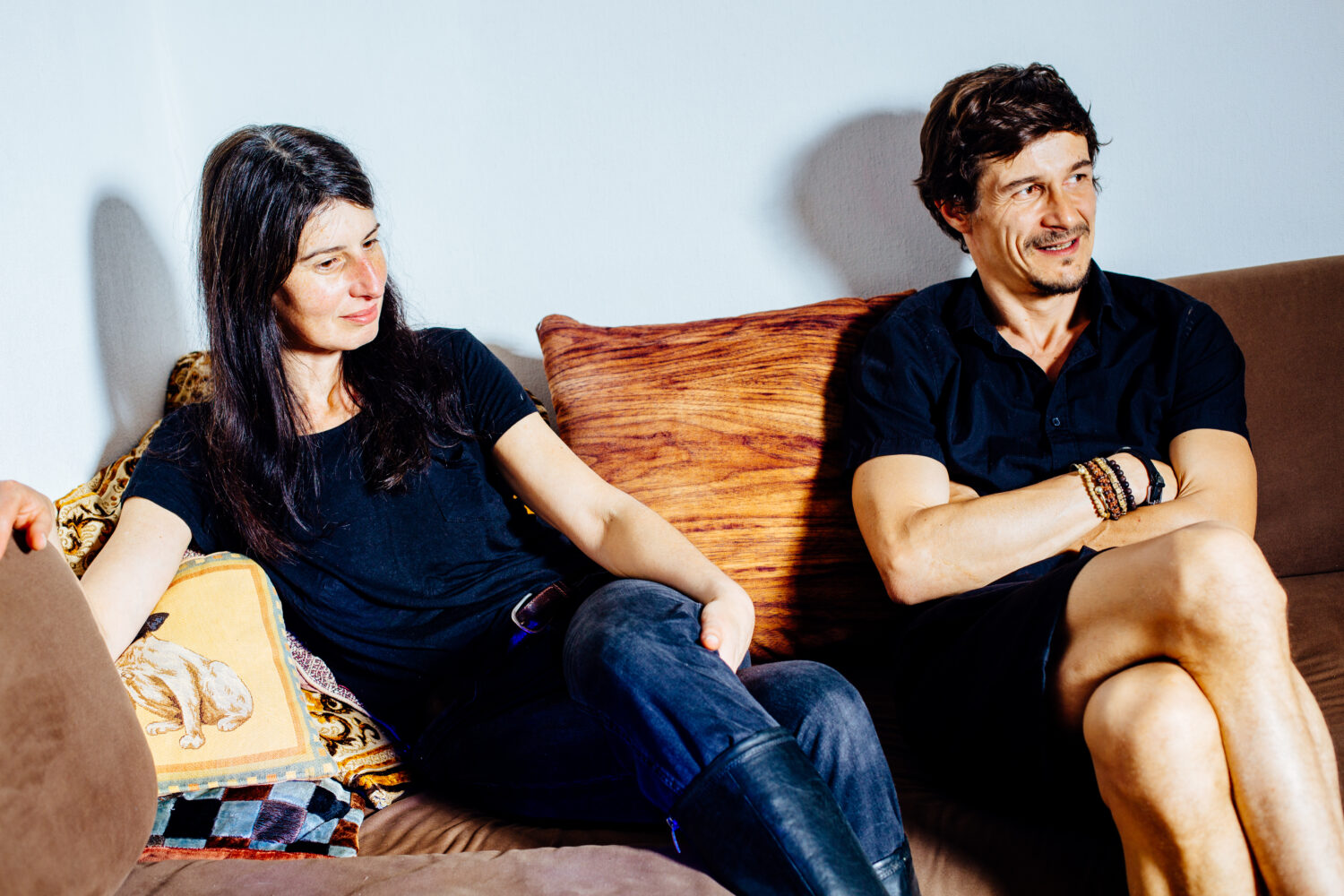
Gabriela Carrizo and Franck Chartier. Photo Natalie Hill.
Their first work together, Caravana (1999), was a ‘location project,’ which took place in a real caravan, and was performed in public places and parks but never in theatres. It saw the company performing the roles of a family who lived in a trailer home. The performance-focused on a couple whose everyday life could only be seen by peeping in through the windows of the vehicle. This first production introduced a recurrent motif for their performances: a family home as the location where the action takes place. It could be suggested that the main topics of Peeping Tom’s work are the intimacy and family dynamics that exist behind closed doors. When this is then performed, Carrizo and Chartier place their audience in a dualistic position “as both a guest and a voyeur.”[2]
The company’s first trilogy Le Jardin [The Garden], Le Salon [The Living Room], and Le Sous Sol [The Cellar] created between 2002 and 2007, tells a story of a house whose inhabitants are struggling with their emotions; they battle through old memories and unfulfilled desires. From this trilogy, the company worked to master the art of creating a universe where a hyper-realistic set design is filled with a surrealistic world of hopes and fears, “as though Pina Bausch and Monty Python joined forces to stage of Chekhov.”[3] This contrast of the real physical world and the unreal moving of a physical body expressing the psychological landscape of its residents became a mandatory condition of all the work of Peeping Tom thereafter.
For the second and most recent trilogy, the artistic directors split their efforts for directing the different pieces. Chartier directed part one, Vader (Father, 2014), Carrizo directed the second part, Moeder (Mother, 2016), and they came together to create the third piece, Kind (Child, 2019).
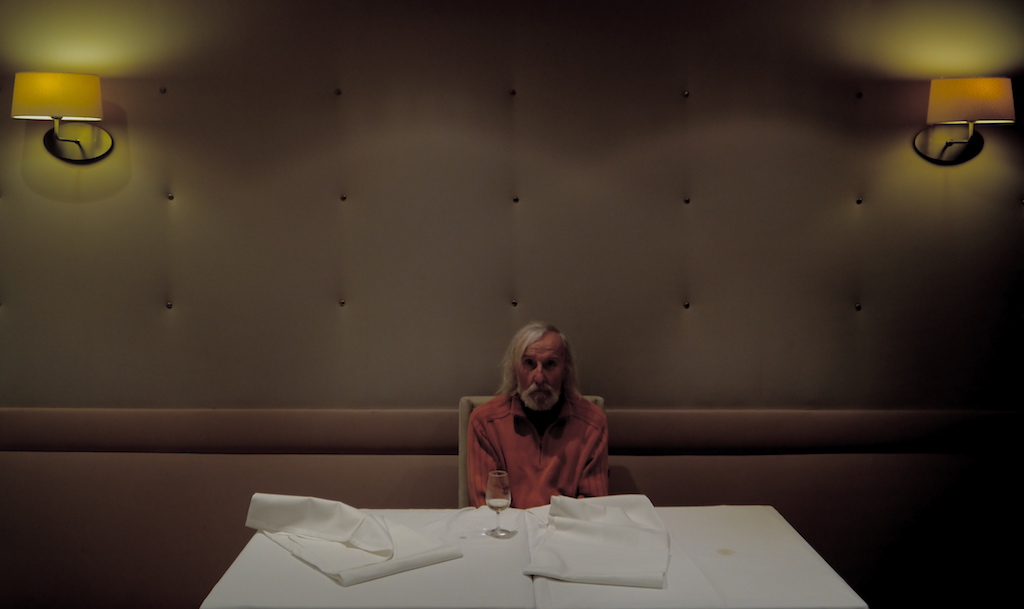
Leo De Beul in Father (Vader). Photo Marie Gyselbrecht.
For Chartier and Carrizo the process of making a new performance begins with the image of the space as the deciding factor for the new work. Chartier explains:
When we started the work on Vader we had only a model of the set. Four or five years before, Gabriela and I led a workshop in a retirement house. There were a lot of funny but also sad moments. It was then that we decided to create a performance about that kind of place. So, we knew where we were, but we didn’t yet know who we were.[4]
Their ensuing work can take several stages. The first stage of the creative process is preparation, mainly intellectual work which involves coming up with ideas and discussing them. This is then followed by exploration – a period when research tasks are carried out and all of the necessary material is generated; gradually proceeding from a broad and abstract concept, and narrowing down to the smaller details. The third stage of the creative process is montage– the organization of the accumulated material in the composition of the final work. Sharing the performance and making the final edits in the first weeks of the show constitute the fourth, and final stage of the process.
These four stages may be identified as common for many theatre-makers and choreographers working with collaborative processes. In the case of Peeping Tom, the lineage of this method can be traced back to Pina Bausch. It was Pina Bausch who developed these methods for the dance studio out of necessity when creating her version of Macbeth in 1978 at Bochum, working with a diverse cast of dancers, actors, and even a confection seller.[5] Alain Platel of les ballets C de la B, whose work is influenced by Bausch, follows a similar methodology and is interested in the performers’ personality. He regarded Bausch’s works “as a trigger”[6] of his aesthetics, and used this way of working at les ballets C de la B, where Carrizo and Chartier were his dancers.
At the beginning of the process, during the preparation stage, the directors present the company with an idea to explore. For example, in Vader it was the notion of regret. Chartier recalls:
We start with research. It takes normally two or three days during which we gather around a table to talk about the subject in the broadest sense possible to open it up in all its entirety from all possible perspectives, and then we put our research on paper. It is a very extensive discussion.[7]
In Moeder, the starting point for the set was the idea of the absence of a mother. Carrizo was thinking about a realistic, cold public space of a funeral hall (her mother had died a few months before the work started). Carrizo also wanted to work with live sound and foley artists. The association with a museum as a place for memory also came up during the discussions at this stage of the work. Later, found pictures of an American funeral space where people can look in through a window at coffins inspired the complex, layered set design. It included an incubator as a recording studio, where voice over was performed, which was situated in the museum of one family – all positioned within the same space.
After the discussion period, where challenging questions are examined and ideas are shared, the physical work in the studio begins. This work in the rehearsal studio takes 4 to 5 months (working eight hours a day, five days a week), out of which two months are dedicated purely to exploration and creating material. During this exploratory period, the artists do not think about evaluating and selecting, they just generate new material. Chartier says:
Each day we come up with a smaller subject that constitutes our big one. We try and frame it, make it smaller, and focus on something tiny. How long we spend working on each such subtopic varies widely. In addition to that, we provide our dancers with specific exercises for physical interpretation that are meant to help them in unveiling the subject.[8]
European director’s theatre used to operate under the notion that everything that happens on stage is primarily the director’s vision. Collaborative processes, however, operate under different rules. Here the personality of the performer is crucial, as they devise characters from their feelings and experiences. One of the company’s dancers, Brandon Lagaert, describes his experience:
The length of the rehearsal process gives you a chance to make your performance more personal. Because at the beginning you show things that you’ve prepared beforehand, how good you are at dancing, but after two months, there’s nothing left, and you start digging into yourself, you start talking about your emotions, about your feelings and memories.
The work on Kind began with a workshop with children, to observe their habits and behavior. The set had already been decided as a forest and mountains, instead of a family house, and the core idea was that of absent parents. Opera singer Eurudike De Beul, one of the longest standing company members, was participating in this workshop. She began to adopt a child’s behavior and gradually reconstructed a child’s world within herself. Before this point, no one could imagine that she might become the main character of this piece. This chance discovery allowed to make the plot much stronger rather than just using children as extras in the piece. In Kind, the audience can see this transformation on stage through the actions of an elderly woman playing the child, while a naturalistic forest landscape is created by builders, to reflect a child’s world whilst growing up. This example shows how Peeping Tom uses the method of devising to reveal the possibilities of encompassing the worlds of others into the world of the piece.
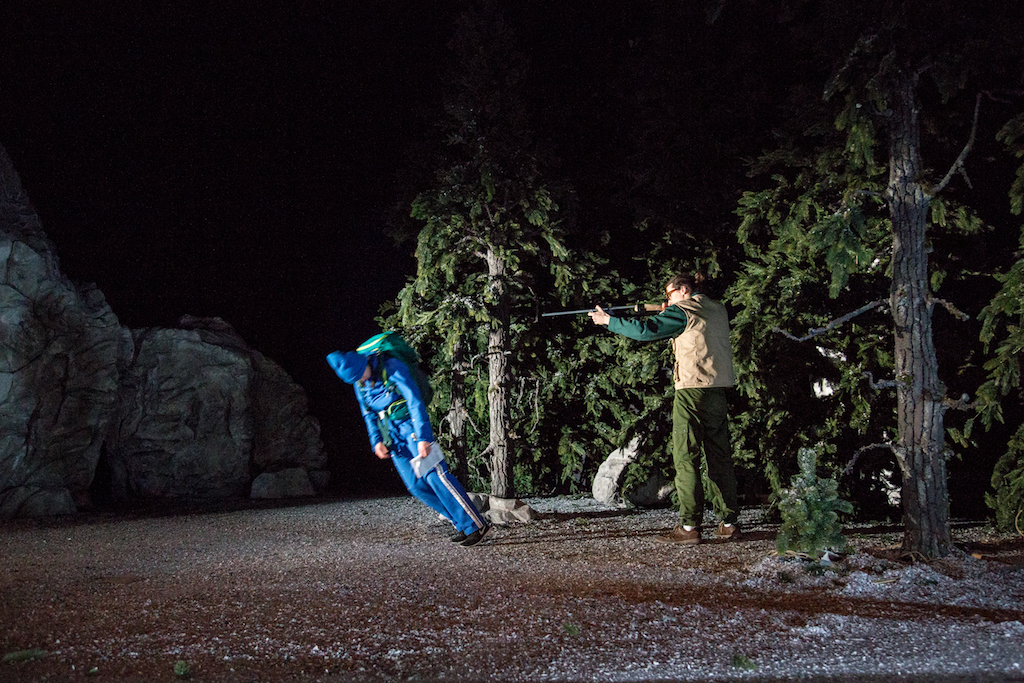
Kind (Child). Photo Oleg Degtiarov.
Just like at les ballets C de la B, artists from different continents, cultures, and artistic techniques coexist within the performances of Peeping Tom. Dancer Maria Carolina Vieira confirms:
We need to surprise our directors all the time, and it is a great pressure. But on the other hand, you can explore your vulnerability and non-skilled side; how to turn it into a strong point. Every creation is an effort to explore and re-create yourself from scratch.[9]
In contrast to a classical dance company, the company doesn’t offer dance classes or collective warm-ups before the work begins, instead, the performers prepare themselves for the rehearsals independently. Similarly, they use their true identities during the work; nothing is pre-determined before the rehearsals begin.
That is why it is so hard to define their criteria for casting. Peeping Tom brings together dancers, opera singers, sportsmen, acrobats, and artists into one united artistic sphere. Chartier uses the phrase “flashed by this person” to describe the moment he is captivated by a dancer’s talent and presence:
There are a lot of amazing dancers. They need to be trained, but our dancers come from different backgrounds. We need to see how performers use what they have to express their feelings. I need to see the reason why she is doing this, that it is not just a beautiful movement. For example, during the audition Brandon [Lagaert] was standing in between people who were walking on their heads, whereas he could merely touch his feet. It is not about how well-trained you are. It is about when you watch dancers on stage and can’t keep your eyes off of them.[10]
The third stage of the working process is the montage– creating a compositionally solid sequence from the material. All rehearsals are recorded; the directors then watch the footage and cut it into pieces. For each piece, there is a ‘ticket’, which are ‘special cards with the names of scenes on them.’[11] These tickets are then placed on a large sheet of paper with a timeline of beginnings and endings of the scenes, and they use different colors for the different characters. This allows the artists to visualize what is happening and where the ‘journey’ is taking them in the piece.[12] This visual organizer is not dissimilar from that tool that is known in cinema as storyboarding – it is notable that during the creating of 32, rue Vandenbranden, the company worked with the film editor Nico Leunen as a consultant.
Following this, tasks are then assigned to dancers using the ‘tickets’ as a creative prompt. Chartier says: “We assign tasks to our dancers using the tickets. They work on them and then show us their results.”[13]
Even at this stage of the process, the directors don’t give a lot of feedback, especially negative feedback, as Chartier and Carrizo believe that criticism could ruin the creative atmosphere in the rehearsal room.[14] Once a week they hold a big improvisation session where chosen scenes are improvised together to find organic and coherent narrative threads. The collaborative and intuitive nature of the work is fundamental in this part of the creative process.
Brandon Lagaert describes his experience:
We produce a lot of material, beautiful material. And throw away a lot of it. Not because it is not good, but because it doesn’t suit our characters. I would say, the final piece represents 5% of our work in the studio.Every other Friday we have a big improvisation session, 3 to 4 hours where we work on our best scenes. For example, I have 50 ‘Wow!’ scenes, some of them solo, some in duet, and I need to put some of them in my improvisation. I don’t know when, I don’t know how, they just need to be in improv before I finish. It is a way of creating organic transitions that we would have never come up with by trying to connect the scenes intentionally. [15]
Carrizo notes that this process carries on outside the rehearsal room:
Some decisions we make in the rehearsal room and some of them at home, for example. During the creation, you think about the work all the time. It happens that some decisions are dramaturgically right, but when we try them, they don’t suit the dynamic of the work; energetically they aren’t right. It’s a very intuitive process.[16]
The premier of work doesn’t mean the end of the creative process. Lagaert notes:
Nothing is set before the premiere. And even after it, we always have notes from our directors. Franck and Gabriela are always with us on tour, and I don’t know other companies where the directors are so much involved in the production.[17]
This is the fourth stage of the creative process, sharing the performance. The work doesn’t end here, even following the production’s premiere. Talking with Carrizo on the next day after the opening night of Kind confirms this: she tells me that she still sees that some parts need to be edited and others to be developed further…
For Peeping Tom the notion of family has always been a reference point. The family is neither just an environment where the actions take place, nor is merely a source of memories, but it is also the strength of the connections and relationships of the ensemble members. Some artists have been part of Peeping Tom since its establishment, others leave and return, bringing with them new members of the family. This is how Leo De Beul, Eurudike De Beul’s father joined the company. He is now the emblematic protagonist, the ‘face’ of Vader. Chartier and Carrizo, a couple in real life as well as on stage, performed with their own infant daughter in Le Salon. Ten years later this scene was repeated in Kind with Lagaert and Vieira, another real couple formed in the company.
Arguably, a family might be seen as a group consuming lots of emotional energy and can generate traumas for its members, yet the same unit can also inspire and fuel artistic work. One performs old fears and memories on the stage and stays in the family on and off stage, and occasionally allows strangers peeping.
Resources:
Carrizo, Gabriela, interviewed by Chernenko, Zhanna (unpublished), 24 April 2019, Luxemburg.
Chartier, Franck, interviewed by Chernenko, Zhanna (unpublished), 2 February 2019, London.
Dierckx, Lieve, ‘Gabriela Carrizo en Franck Chartier / Peeping Tom’, Contemporary dance from Flanders, 2015. https://dossiers.kunsten.be/dance/portrait/peeping-tom
Hahn, Thomas, ‘Trailer Park. The unique stagecraft of Brussels theatre collective, Peeping Tom’, Magazine im August, 6 August, 2016. http://magazinimaugust.de/2016/08/06/peeping-tom-the-gang-from-the-trailer-park/
Lagaert, Brandon, public talk after a workshop with the artist, 3 February 2019, London.
Trencsényi, Katalin, Introduction. What’s the point of Bandoneon? in Hoghe, Raimund – Ulli Weiss, transl. Penny Black, ed. Katalin Trencsényi (2016), Bandoneon. Working with Pina Bausch, London: Oberon Books, pp.6-70.
Vieira, Maria Carolina, public talk after a workshop with the artist, 3 February 2019, London.
Wiegand Chris, ‘Pina Bausch tributes: “She got the keys to your soul”’, The Guardian, 3 July, 2009. https://www.theguardian.com/stage/2009/jul/03/pina-bausch-tributes
***
[5]Trencsényi, 2016, pp. 31–40.
Zhanna Chernenko is a London-based theatre-maker, writer, and director, who explores problems of identity in modern society using a combination of contemporary dance, drama, and visual arts. Before working in theatre, she worked as a journalist and a film-maker in Russia. She holds an MA in Text & Performance from RADA and Birkbeck, University of London.
This post was written by the author in their personal capacity.The opinions expressed in this article are the author’s own and do not reflect the view of The Theatre Times, their staff or collaborators.
This post was written by Zhanna Chernenko.
The views expressed here belong to the author and do not necessarily reflect our views and opinions.


